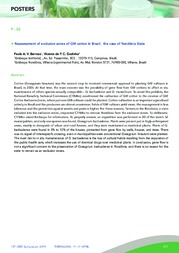Reassessment of exclusion zones of GM cotton in Brazil: the case of Rondônia State.
Reassessment of exclusion zones of GM cotton in Brazil: the case of Rondônia State.
Author(s): BARROSO, P. A. V.; GODINHO, V. de P. C.
Summary: Cotton (Gossypium hirsutum) was the second crop to received commercial approval to planting GM cultivars in Brazil, in 2005. At that time, the main concern was the possibility of gene flow from GM cottons to affect in situ maintenance of others species sexually compatible ? G. barbadense and G. mustelinum. To avoid this problem, the National Biosafety Technical Commision (CTNBio) conditioned the cultivation of GM cotton to the creation of GM Cotton Exclusion Zones, where just non-GM cultivars could be planted. Cotton cultivation is an important agricultural activity in Brazil and the producers are almost unanimous: fields of GM cultivars yield more, the management is less laborious and the protection against weeds and pests is higher. For these reasons, farmers in the Rondonia, a state included into the exclusion zones, requested CTNBio to remove Rondônia from the exclusion zones. To deliberate, CTNBio asked Embrapa for information. To properly answer, an expedition was performed in 20 of the state?s 52 municipalities, and only one species was found, Gossypium barbadense. Plants were present just in higly anthropized areas, mainly in dooryards of urban and rural houses, and they were maintained as medicinal plants. Plants of G. barbadense were found in 5% to 10% of the houses, protected from gene flow by walls, houses, and trees. There was no signal of interespecifc crossing, even in municipalities were conventional Gossypium hirsutum were planted. The main risk to in situ mainatenance of G. barbadense is the loss of cultural habits resulting from the expansion of the public health care, which increases the use of chemical drugs over medicinal plants. In conclusion, gene flow is not a significant concern to the preservation of Gossypium barbadense in Rondônia, and there is no reason for the state to remain as an exclusion zones.
Publication year: 2019
Types of publication: Abstract in annals or event proceedings
Unit: Embrapa Territorial
Keywords: Gossypium barbadense
Observation
Some of Embrapa's publications are published as ePub files. To read them, use or download one of the following free software options to your computer or mobile device. Android: Google Play Books; IOS: iBooks; Windows and Linux: Calibre.
Access other publications
Access the Agricultural Research Database (BDPA) to consult Embrapa's full library collection and records.
Visit Embrapa Bookstore to purchase books and other publications sold by Embrapa.

